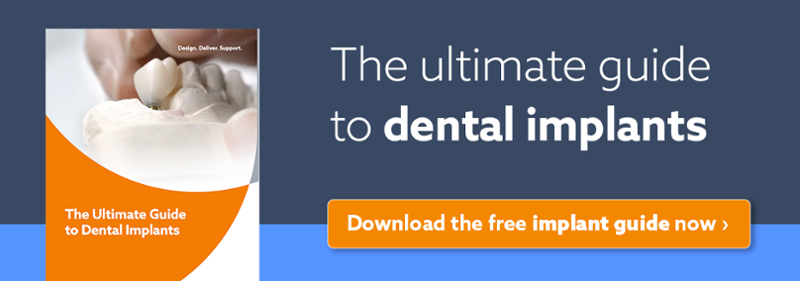Historically, implant abutments were always manufactured from metal and were either prefabricated or custom-made. Zirconia implant abutments provide a highly aesthetic solution, especially for specific clinical situations. Zirconia abutments are very versatile, as they can be designed entirely using CAD/CAM technology or by scanning a wax-up before milling the abutment. Both options allow a zirconia abutment to be efficiently designed and created.
When to Choose a Zirconia Implant Abutment
One reason for choosing a zirconia abutment is when a patient has a particularly thin gingival tissue or periodontal biotype. Where the gingival tissue is thinner, it can expose the greyish hue of a titanium abutment implant in the cervical third of the implant restoration. This can detract from even the most beautifully-made implant crown. A thin gingival tissue is unable to block the reflected light from metal abutments, therefore selecting a zirconia abutment can overcome these limitations. One simple way to test if a patient has thinner gingival tissue is to simply insert a periodontal probe into the gingival sulcus. If it’s easy to see the probe through the tissue, then the patient has a thin periodontal biotype. Using a zirconia implant abutment will give a far more aesthetically-pleasing appearance when the patient’s gum line needs to be considered. It also avoids the problem of trying to match the shade of adjacent teeth while hiding the colour of a titanium abutment.
Clinical Advantages of Choosing Zirconia Implant Abutments
Zirconia abutments have excellent mechanical strength and reliability. The biocompatibility and microstructural properties of zirconia are well known. In addition to its favourable mechanical properties, the material is thought to accumulate less dental plaque compared to titanium. It is possible that the peri-implant soft tissues around zirconia may heal more quickly compared to peri-implant tissues in contact with titanium.
Addressing Concerns over Strength
One of the main concerns clinicians have about using zirconia abutments is the material’s strength and whether it will fracture. Although zirconia is very strong, it doesn’t have the same type of strength as metal, particularly in areas where the abutment may be thinner. Sometimes due to the position of the implant, the abutment must be designed in such a way that the axial walls may be excessively thin. If this is the case, zirconia may not be a suitable abutment material. Zirconia abutments can be constructed as a one-piece with a metal insert, but the connection to this fixture significantly affects the strength of the abutment. This is because the weakest part of a zirconia abutment is at the level of the internal connection. It’s possible to achieve superior strength when using zirconia implant abutment sor hybrid abutments by utilising an internal connection via a secondary metallic component. Zirconia implant abutments can be more successful when used in areas of lower force such as when restoring anterior teeth rather than posterior teeth, and ideally should have a secondary metal component for the internal connection into the implant.
Zirconia can be an excellent material for manufacturing implant abutments, as it has high compressive strength and good aesthetics. However, it has lower tensile strength and fracture toughness compared to titanium. These factors do have to be considered when designing zirconia implant abutments. Generally, the shanks of zirconia abutment screws are smaller compared to those used for titanium abutments. Using a smaller diameter helps improve the performance of the connection between the abutment and the implant, reducing the risk of the screw loosening over time. When used in the correct clinical situations, a properly-designed zirconia abutment can eliminate aesthetic concerns when restoring anterior teeth.
Please be reminded that our experienced technical team is here to assist you should you wish to discuss a case in more detail.
Click here to schedule a consultation with our technical team »

References:
http://thecuriousdentist.com/when-should-we-use-a-zirconia-implant-abutment/
https://www.speareducation.com/spear-review/2016/07/how-to-achieve-success-with-custom-zirconia-abutments
https://www.researchgate.net/profile/Ulf_Oertengren/publication/45114724_Zirconia_as_a_Dental_Implant_Abutment_Material_A_Systematic_Review/links/0deec5277e794af5d1000000/Zirconia-as-a-Dental-Implant-Abutment-Material-A-Systematic-Review.pdf
http://glidewelldental.com/education/inclusive-dental-implant-magazine/volume-2-issue-4/optimizing-the-design-of-zirconia-implant-abutments-a-finite-element-analysis/